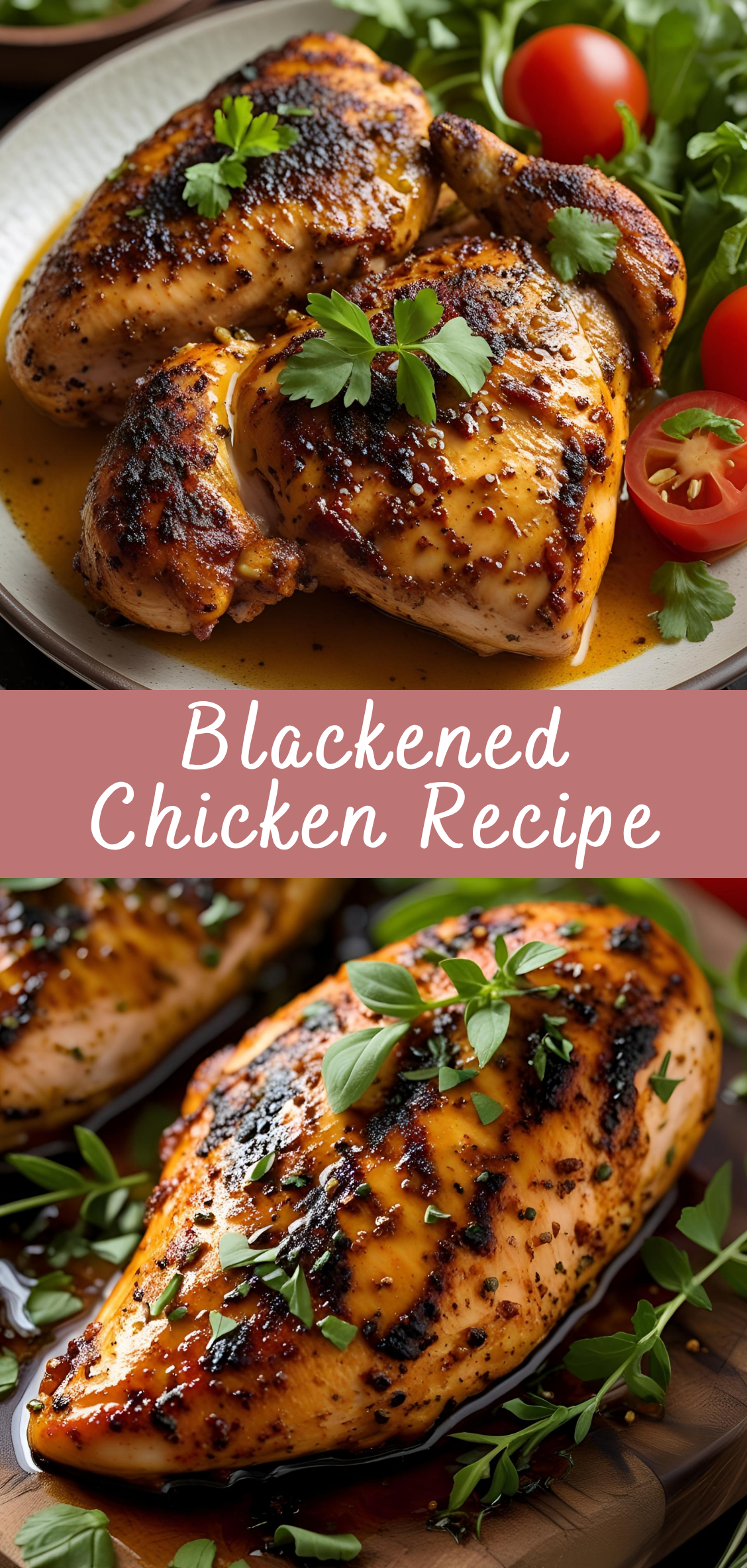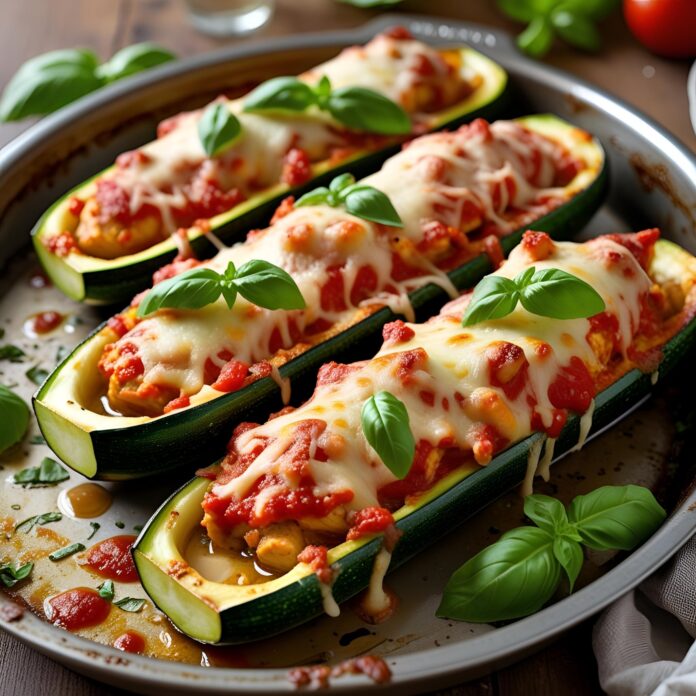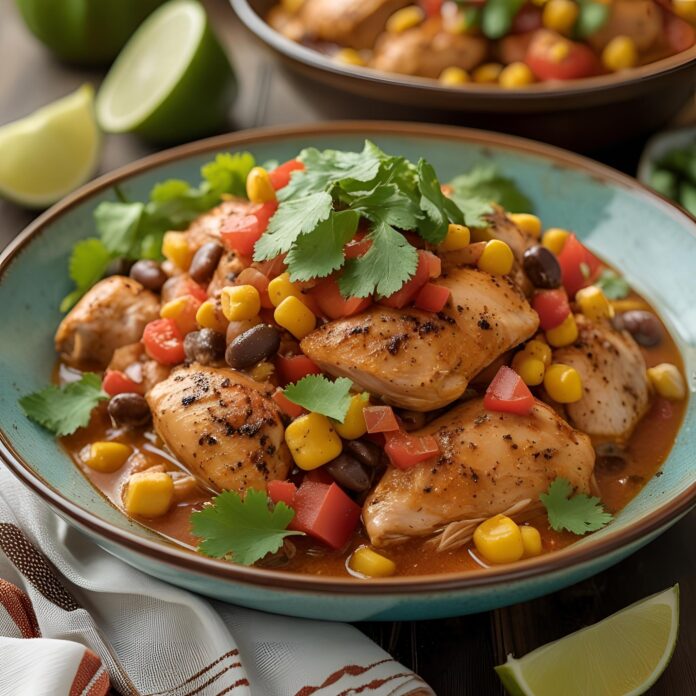Blackened Chicken Recipe
Blackened chicken is a vibrant and flavorful dish rooted in Cajun and Creole culinary traditions of Louisiana. It is renowned for its bold, smoky, and spicy profile, achieved through a specific cooking method that involves coating the chicken in a blend of robust spices and cooking it over high heat until a dark, almost charred crust forms. This technique, while seemingly simple, produces a complex interplay of textures and tastes that have made blackened chicken a beloved staple in both home kitchens and upscale restaurants across the United States and beyond.

The term “blackened” refers to the characteristic darkened exterior of the meat, created by the intense heat causing the spices to caramelize and the natural sugars and proteins in the chicken to undergo a Maillard reaction. This not only imparts a distinctive smoky aroma but also locks in the juices, resulting in a tender and moist interior that contrasts beautifully with the crisp, flavorful crust.
The origin of blackened cooking is often credited to Chef Paul Prudhomme, who popularized this style of seasoning and cooking in the 1980s. Prudhomme’s approach was to create a seasoning mix that could transform ordinary ingredients into extraordinary dishes by harnessing the power of bold spices and heat. His method of using cast iron skillets and very high temperatures allowed cooks to achieve that signature blackened effect quickly, preserving the flavor and moisture of the food.
Blackened chicken stands apart not just for its taste but also for its versatility. It can be served as a main dish accompanied by traditional Southern sides like rice and beans, creamy coleslaw, or cornbread. It also works well sliced over salads, nestled in sandwiches or wraps, or served alongside pasta or vegetables for a lighter meal. The dish caters to those who appreciate a well-balanced heat without overwhelming the palate, and it offers a healthy protein option that is lower in fat compared to fried or breaded preparations.
Understanding the nuances of blackened chicken involves appreciating the role of each component in the seasoning blend — from the earthy smokiness of paprika and cayenne pepper to the pungent sharpness of garlic and onion powders, and the warmth of dried herbs like thyme and oregano. These spices work in harmony to build layers of flavor that penetrate the chicken during cooking, making each bite rich and satisfying.
Mastering the technique of blackening chicken requires attention to the heat and timing to avoid burning the meat while achieving the desired crust. The choice of cooking fat, the thickness of the chicken pieces, and the type of pan used all influence the final outcome. Traditionally, clarified butter or a high smoke point oil is used to coat the chicken and help the spices adhere, as well as to facilitate even cooking.
This recipe guide will explore every facet of preparing perfect blackened chicken, from selecting the best cuts of chicken and mixing the ideal spice blend to cooking tips and variations that allow you to tailor the dish to your personal preferences. Whether you are an experienced cook looking to refine your technique or a newcomer eager to explore bold flavors, this comprehensive guide will equip you with all the knowledge and confidence needed to create a memorable blackened chicken meal.
The History and Cultural Significance of Blackened Chicken
Blackened cooking has deep roots in the rich culinary traditions of the American South, particularly in Louisiana’s Cajun and Creole cultures. These traditions are themselves the result of a complex blend of influences, including French, Spanish, African, and Native American cuisines, all converging to create a regional food culture that celebrates bold flavors and innovative techniques.
The specific technique of blackening emerged as a method of cooking that made use of local ingredients and simple, readily available kitchen tools. It was a way to impart intense flavor to affordable cuts of meat and fish, making the most of what was on hand. Blackening was particularly suited to seafood, given Louisiana’s proximity to the Gulf of Mexico and the abundance of fish and shellfish in the region. However, the technique quickly adapted to chicken and other proteins, expanding its popularity and reach.
Chef Paul Prudhomme is widely credited with popularizing blackened cooking in the early 1980s. His innovative approach brought Cajun cuisine into the national spotlight, particularly through his work at K-Paul’s Louisiana Kitchen in New Orleans. Prudhomme’s signature blackened redfish became a sensation, inspiring home cooks and chefs alike to experiment with the technique. His philosophy emphasized the power of seasoning and heat to transform simple ingredients into something extraordinary, a philosophy that still resonates in kitchens today.
Beyond its culinary appeal, blackened chicken also reflects a larger cultural story about resourcefulness and identity. The spices used in blackening blends are deeply symbolic of Southern cooking’s reliance on bold flavors to enliven dishes. Paprika, cayenne pepper, garlic, and herbs like thyme and oregano are staples of the region’s pantries, representing a heritage of trade, adaptation, and innovation. These spices were historically valued not only for their flavor but also for their preservative and medicinal properties.
As blackened chicken gained popularity, it transcended its humble beginnings to become a symbol of Southern pride and culinary ingenuity. It showcases how traditional cooking techniques can evolve and adapt, merging old world influences with new world creativity. Today, blackened chicken is celebrated across the United States, from casual backyard barbecues to fine dining establishments, each adding their own twist to the classic preparation.
The dish also aligns with contemporary culinary trends emphasizing bold flavors, whole ingredients, and quick, high-heat cooking methods. It offers an alternative to fried or heavily breaded chicken, appealing to health-conscious diners who crave spice and depth without excess fat or calories.
In this guide, you will not only learn how to recreate blackened chicken at home but also gain an appreciation for the cultural and historical context that makes this dish so special. Understanding the story behind blackened cooking enriches the experience of preparing and enjoying it, connecting each bite to a larger narrative of tradition, innovation, and celebration.
Blackened Chicken Recipe
Blackened chicken is a vibrant and flavorful dish rooted in Cajun and Creole culinary traditions of Louisiana. It is renowned for its bold, smoky, and spicy profile, achieved through a specific cooking method that involves coating the chicken in a blend of robust spices and cooking it over high heat until a dark, almost charred crust forms. This technique, while seemingly simple, produces a complex interplay of textures and tastes that have made blackened chicken a beloved staple in both home kitchens and upscale restaurants across the United States and beyond.
Ingredients
- 4 boneless, skinless chicken breasts
- 2 tablespoons paprika
- 1 tablespoon garlic powder
- 1 tablespoon onion powder
- 1 tablespoon dried thyme
- 1 tablespoon dried oregano
- 1 teaspoon cayenne pepper (adjust to taste)
- 1 teaspoon black pepper
- 1 teaspoon salt
- 1/2 teaspoon cumin
- 2 tablespoons olive oil or melted butter
Instructions
- Prepare the spice mix:
In a small bowl, combine paprika, garlic powder, onion powder, thyme, oregano, cayenne pepper, black pepper, salt, and cumin. Mix well. - Season the chicken:
Pat the chicken breasts dry with paper towels. Rub the olive oil or melted butter evenly over both sides of each chicken breast. Then generously coat each piece with the spice mix, pressing the seasoning into the meat. - Preheat the pan:
Heat a cast-iron skillet or heavy-bottomed pan over medium-high heat until very hot (about 3-5 minutes). - Cook the chicken:
Place the chicken breasts in the hot pan. Cook undisturbed for about 4-5 minutes on one side until a dark crust forms. Flip and cook another 4-5 minutes on the other side, or until the chicken is cooked through and the internal temperature reaches 165°F (75°C). - Rest and serve:
Remove chicken from the skillet and let rest for 5 minutes before slicing or serving.
Notes
- Use a cast-iron skillet for best results — it retains heat well and helps develop that signature blackened crust.
- Adjust cayenne pepper based on your heat preference.
- You can use this seasoning blend on fish, shrimp, or pork as well.
- Serve with rice, veggies, or a fresh salad for a complete meal.



